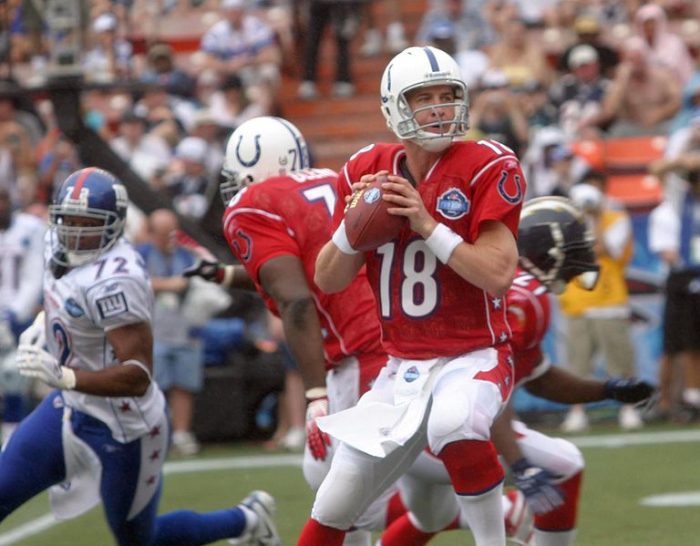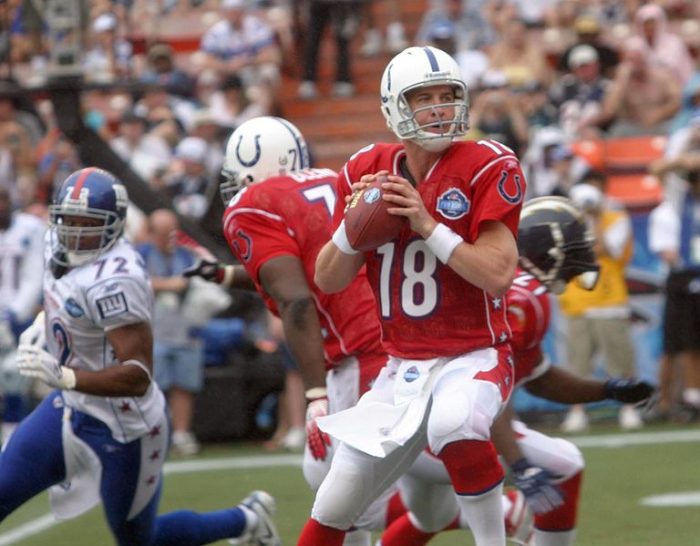
One of the more telling aspects of gauging a quarterback’s readiness for the NFL is how he manages pressure in the pocket. If the first response is to retreat, there’s work to be done. It doesn’t matter if a quarterback has the athleticism to break loose of defensive ends and outrun cornerbacks, the passer still needs to harness his physical skills to meet the demands of the position. He may win some of these battles by tucking the ball and making a timely flight from the confines of the pocket, but he’ll ultimately lose the war.
Terrelle Pryor is a much better passer in 2013 than he was at Ohio State. His performance against the Colts on Sunday was entertaining and he’ll win some of these games. But until he can read the defense rather than try to exhaust it, he’ll ultimately lose. Say all you want about the state of the Raiders but as much as Pryor put his team into position to win, he was the biggest reason why they lost in the end.
Tajh Boyd is a winning college quarterback. CBS play-by-play commentator Brent Musberger told his audience during the Georgia-Clemson contest that some scouts he’s talked to say that Boyd reminds them of Russell Wilson. This is no more accurate than saying South Carolina and North Carolina are alike. Just like the Cackalackies are in the same region, Boyd and Wilson are both mobile quarterbacks with some improvisational skill. This is where the comparison ends.
To the average viewer there’s little difference because both are mobile and can generate big plays when they escape the pocket. To elaborate on what Greg Cosell means when he talks about the importance of a quarterback winning from the pocket is that a top NFL quarterback must possess the skill to win from the pocket even if he’s not a strictly a pocket passer. Wilson was far better at managing the pocket than Boyd by his junior year. Although Wilson had his share of plays where he had to improvise, he was more consistent at maneuvering away from defenders with his feet in position to make accurate passes down field.
Boyd is in an offense where his best passing plays on the move are by design. When the pocket breaks down, the Clemson passer still has to improve his technique. He displays some good things under pressure – including basic footwork – but not enough to be a winning starter in the NFL early in his pro career. Here are four plays from the Clemson-Georgia game that say a lot about the state of Boyd’s pocket game at this point of his career.
Good Feet – Good Improvisation
This is a 3rd-and-four pass with 11:22 in the first quarter. Clemson uses an 11 personnel, 2×1 receiver set and the primary option is Sammy Watkins who runs a slant-and-go coupled with Boyd’s pump fake off a quick play fake. However, the play breaks down fast. There are a lot of thinks happening fast on this play so you may have to watch the tape a few times.
[youtube=http://youtu.be/DVtwlQaLtR4]
Boyd fakes the ball to the runner, who drifts to the left edge to block the outside pressure. The quarterback sets his feet and delivers a quick shoulder fake as the pump fake on this first half of Watkins’ double move – the slant. As Boyd sets his feet, he sees the edge rusher begin with an inside path. The Clemson quarterback makes the appropriate reaction begins to move outside the defender’s path. However, the defender only fakes inside and dips outside the runner.
Boyd does a fine job of switching his feet the way coaches teach quarterbacks in drills. This switch orients Boyd so he can climb inside the pressure. He escapes to the left flat, turns his shoulder to the target and delivers the ball with a sidearm release on the run to his receiver Watkins, who does an excellent job reading the situation and working back to the quarterback.
This is a strong adjustment and a good example of quality footwork. However, the difference between Body and a quarterback like Wilson is that Wilson has illustrated that he will often wait a split-second longer for the edge rusher to declare his position and then react. If Boyd does the same, he either draws the defender inside and has a better path to the edge with a roll-out or the defender takes the outside path, Boyd never makes that initial move to the outside and he has an easier time climbing the pocket to deliver the ball in a spot where Watkins may not have to work back to a spot.
It’s a small detail, but it’s details that reduce errors and generate big plays. It’s why in college football Terrelle Pyror and Russell Wilson are both “stars” but one is far ahead of the other at the NFL level and it has nothing to do with the quality of surrounding talent.
Sometimes the option isn’t to move.
There are times where a quarterback has to recognize that he must stand in the pocket and deliver the ball fast or miss an opportunity for a positive play. Boyd’s second touchdown of the night is a good example. This is an 11-yard slant thrown with a sidearm release and behind Watkins from a 2×1 receiver, 11 personnel set with 9:10 in the first quarter. Georgia is playing a 3-4 defense with both safeties deep and the cornerbacks playing off the outside receivers.
[youtube=http://youtu.be/3BnbLIC5yyM]
Boyd begins the play with a thorough play fake on the zone read action, getting the ball in and out of the belly of the runner. The pressure doesn’t buy the fake and constricts the edges of the pocket. It’s a quick reaction by Boyd to deliver the ball. Note that he doesn’t move his feet between the time he retracts the ball from the belly of the back through the release of the ball. This is fluid play-making.
While Watkins work at the catch point and after the catch is the attention-getter, the fact that Boyd reacts this fast and isn’t robotic about his form at the cost of missing this play is a good thing. I like that Boyd can process this fast in the short game. If he can demonstrate this skill with greater consistency in the deep intermediate and deep game and throw receivers open, he’ll be on his way to becoming a good pro prospect. Check out the section of this article on Russell Wilson where he throws open his receiver against a double A-gap blitz from Virginia Tech as an example.
Interior Pressure
Here is an attempt to the running back Rodrick McDowell on a 3rd-and-5 check-down with 13:50 in the first quarter. Once again, Clemson is operating from a 2×1 receiver, 11 personnel pistol.
[youtube=http://youtu.be/SV3SYMr-970]
The linebacker does a solid job of disguising the pressure, but Boyd still has time to react. This is also true of the defensive lineman whose helmet is to the inside shoulder of his blocker on the same side of the blitz. Boyd needs to read these two defenders and climb the pocket to the opposite side. If he steps up and delivers the ball with his feet under him to the runner in the flat, it’s likely a completion.
Boyd’s reaction is to retreat. He slides to the right while backing away and throws the ball off his back foot with the defender wrapping him. The pass is too high for the receiver. Tough play, but good pro quarterbacks make this tough play look easy. Interior pressure is difficult for every quarterback, but with this much lead time and the position of these defenders, a good pro handles it.
Quick Decisions Need to become more consistent
Boyd has to become more decisive and use it to harness his athleticism into a weapon that doesn’t self-destruct. This is a 3rd-and-8 pass with 2:36 in the first quarter from a 2×2 receiver, 10 personnel pistol. There’s press coverage on this play and outside linebackers threatening pressure off the edge. No.84 is running a twist with the defensive end at the bottom of the screen.
[youtube=http://youtu.be/bBYHyrBxLJA]
This twist distracts the right side of the Clemson line from the defensive end getting a free rush from the edge. Boyd looks left as this is happening and has his running back open in the flat. However, Boyd either didn’t read the threat of pressure off that edge or he’s too confident in his ability to avoid it.
The result is that Boyd holds onto the ball too long while in position to deliver an easy check down to the runner in the flat who has space to run because the defenders on the two outside receivers before the snap drop into coverage. Boyd opts to deal with the defensive end instead, but underestimates the athleticism of his opponent and has to throw the ball away – coming dangerous close to an intentional grounding call.
This is an error in judgement not just with the opponent, but situational football. Take the safe completion on 3rd-and-eight and allow the receiver to do the work after the catch in open space. The running back should be able to make one man miss. That’s his job. If it doesn’t work, it’s still the first quarter in a close game; don’t take unnecessary risks.
I still have more to study of Boyd’s game, but at this point these four plays are an illustration of a player with some feel for the pocket and room to grow, but not enough skill under pressure that I’d compare him with the best prospects of recent quarterback classes.
For analysis of skill players in this year’s draft class, download the 2013 Rookie Scouting Portfolio.The 2014 RSP will available April 1 and if you pre-order before February 10, you get a 10 percent discount. Better yet, if you’re a fantasy owner the 56-page Post-Draft Add-on comes with the 2012 – 2014 RSPs at no additional charge and available for download within a week after the NFL Draft. Best, yet, 10 percent of every sale is donated to Darkness to Light to combat sexual abuse. You can purchase past editions of the Rookie Scouting Portfolio for just $9.95 apiece.









